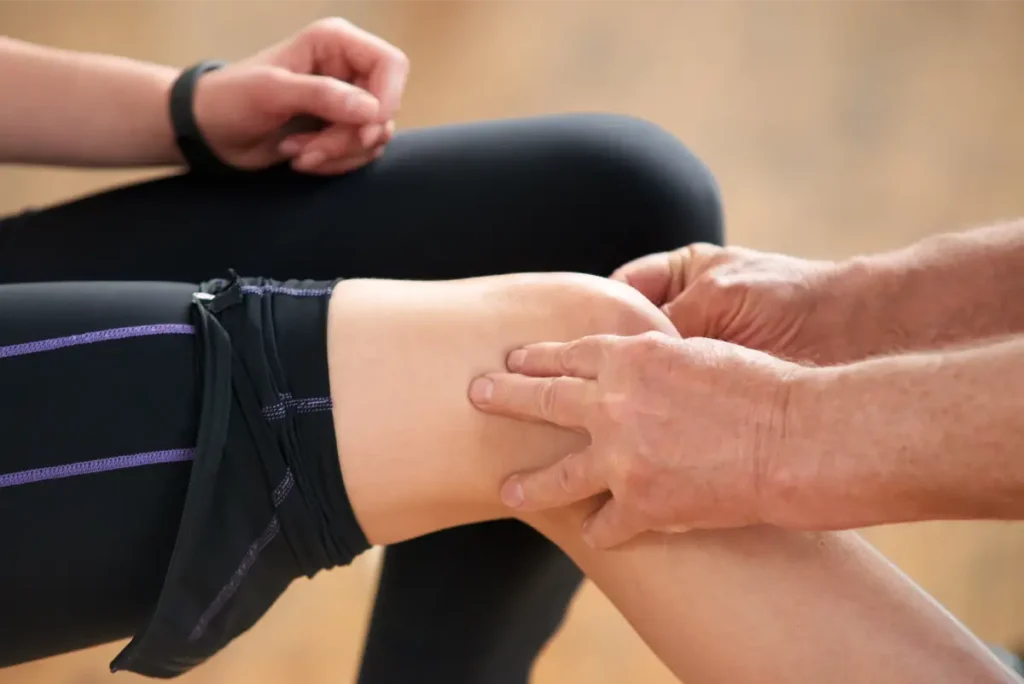Why do I have knee pain?
There are many causes of knee pain resulting from problems with the knee joint itself, as well as problems above and below it. As the knee is stuck between the hip and the ankle, muscle imbalances or weaknesses at these joints can lead to knee pain. Knee pain can also be due to changes in your activity levels (doing a lot more or less exercise or activity than you usually do), injuries, hypermobility and the aging process.
Here are 3 common conditions that might explain your knee pain:
1. ITB syndrome – causes pain at the outside of your knee. Your Illiotibial band (ITB) is a band of connective tissue that runs from the outside of the hip to the knee, its role is to stabilise the two joints. It can lead to pain when there is excessive friction or compression of the IT band and the nerves and tissues below it. This can happen if you have weakness in the gluteal and hip abductor muscles, or instability at your ankles causing your foot to roll in and put more pressure on the outside of the knee. It is also common in runners and cyclists who increase their training suddenly.
2. Knee osteoarthritis – a condition where a loss of cartilage and inflammation at the knee leads to pain. It results from wear and tear at the knee joint, due to the aging process and the strain a person has placed on their joints in the past. Knee osteoarthritis is common in people over 50, those who are overweight and people with a history of knee injuries such as ligament or meniscus (cartilage) tears.
3. Patellofemoral pain – a condition causing pain at the front of your knee, where the kneecap (patella) articulates with the thigh bone (femur). It can be due to overuse and compression of the structures at the front of your knee, resulting from increased sports or exercise (e.g. increasing your squat load of reps or increasing your running distance), increased time kneeling or crouching down (e.g. DIY, cleaning) or other activities that place load on your knees (e.g. driving or gardening). Patellofemoral pain can also occur from genetic factors that influence how the patella moves against the femur, as well as trauma or injury to the knee.
If you are unsure of the cause of your knee pain and how to manage it physiotherapy can help, providing a diagnosis and treatment plan for your knee pain.
How to alleviate knee pain
If you have a sudden / acute injury such as twist or a fall on to your knee, the acronym PEACE and LOVE is a good guide to immediate treatment: Immediately after injury follow the steps of PEACE. After the first few days have passed, follow the steps of LOVE.
PEACE:
Protect in days 1-3. Limit your movement to reduce the risk of aggravating the injury and to minimise bleeding and inflammation.
Elevate – rest your knee on a cushion if lying down to elevate it above your heart level. If sitting elevate it on another chair or stool as high as is comfortable to avoid excess swelling.
Avoid anti-inflammatories in the first 1-3 days as some inflammation is needed for tissue healing.
Compression – use a knee support such as Tubigrip or a light sports support or bandage to prevent excess swelling and make getting around a little more comfortable.
Education – seek advice from a physiotherapist or qualified medical professional if you have any concerns about how to manage your injury, and/or if your pain and swelling is not reducing within 3 – 5 days.
From around 3 days after your injury follow the principles of LOVE.
Load – placing load or weight on your knee as soon as you are able to by starting to walk or stand more is important for recovery. If pain is severe you may need to use crutches or a knee support to enable you to start to move more comfortably.
Optimism – stay optimistic about your recovery as research has shown this leads to better outcomes.
Vascularisation – gentle movement and exercise is important to start to increase blood flow to your knee, prevent excess swelling and stiffness, assisting the healing process.
Exercise, perform gentle knee bends in a sitting or lying position and practice contracting your thigh muscles for a count of up to 10 seconds. Do this 3+ times per day until you can resume usual activity levels. For a more specific exercise programme tailored to your injury and lifestyle, see a physiotherapist.
Gradual/long-term knee pain
Many of these principles also apply to knee pain which occurs gradually and/or has been present for a longer period of time.
Relative rest: If your knee is very painful, short periods of reduced activity can help to settle the pain.
Exercise: A suitable exercise programme to strengthen the muscles around the knee, hip and ankle (specifically your quadriceps, hamstrings, gluteals and gastrocnemius) can be important to fix any weaknesses or muscle imbalances that could be causing your knee pain.
Movement: Low impact exercise which does not involve a lot of jumping or high loading to your knee, such as cycling or swimming, is important to reduce and prevent knee pain.
Bracing: using a knee support can be useful to help stabilise your knee during exercise and periods of walking and standing, and can reduce pain. If you have known osteoarthritis, cartilage or ligament damage, specific braces can provide enough support for you to play sports or lead an active lifestyle with significantly less pain.
if you have knee pain and are unsure what to do about it, and/or the above steps havent helped please see a physio! contact info@clairegurneypilates.com to discuss your symptoms and book an appointment.


